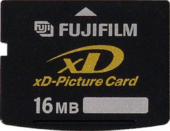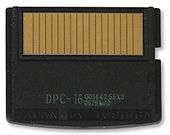xD-Picture Card
 A 16 MiB Fujifilm xD Card | |
| Media type | memory card |
|---|---|
| Capacity |
Maximum 512 MiB (original) maximum 2 GiB (Type M/M+, Type H) |
| Developed by | Olympus, Fujifilm |
| Dimensions | 20 mm × 25 mm × 1.78 mm |
| Weight | 2.8 grams |
| Usage | digital cameras, voice recorders |
xD-Picture Card is a flash memory card format, formerly used in digital cameras made by Olympus and Fujifilm. The xD in the xD-Picture Card stands for eXtreme Digital. It is not used in any cameras currently in production.
xD cards are available in capacities of 16 MB up to 2 GB.
History
The cards were developed by Olympus and Fujifilm, and introduced into the market in July 2002. Toshiba Corporation and Samsung Electronics manufactured the cards for Olympus and Fujifilm. xD cards were sold under other brands, including Kodak, SanDisk, PNY, and Lexar, but were not branded with the respective companies' logos, except for Kodak. Previously, xD competed primarily with Secure Digital (SD) cards, CompactFlash (CF), and Sony's Memory Stick. Because of its higher cost and limited usage in products other than digital cameras, xD lost ground to SD, which is broadly used by cellular phones, personal computers, digital audio players and many other digital cameras.
Olympus began to move away from the xD format with the release of the E-P1 camera, which supported only Secure Digital memory cards.[1] As of Spring 2010, all new Olympus cameras announced at the 2010 Consumer Electronics Show and Photo Marketing Association International Trade Show can use SD cards.[2][3][4][5][6][7] This changeover to the SD card format has never been officially announced by Olympus Corporation. The higher-end DSLR cameras such as the E-3 and E-5 among others continue to use Compact Flash cards as well.
Comparison with rival formats
The xD format has been discontinued. New cards are still manufactured, but cameras supporting xD memory cards exclusively are no longer manufactured.
Advantages
- Contains no flash translation layer (designed to emulate the block device structure of a magnetic disk drive). Better-designed flash file systems can directly access the NAND flash hardware.
- Very similar to a standard NAND chip. Modified XD readers can be used to read arbitrary NAND chips.
Disadvantages
- Card format is proprietary to Fujifilm and Olympus, just as the Memory Stick format is to Sony. No public documentation available (see below for reverse-engineering results). In contrast, the CompactFlash format is described by completely open and free specifications.
- Has not kept up with the transfer rate, or speed, of other cards, notably Compact Flash and SD, but also the later versions of the Memory Stick. The fastest xD card offers less than 10% of the speed of current (2009) Compact Flash cards.
- Directly derived from the Smart Media card. Thus, has no wear leveling controller. May have a shorter life span than comparable cards with FTL wear levelers if the file system used does not take into account wear leveling.
- Generally more expensive than other memory card types. As of September 2009, 2 GiB xD cards' retail prices are approximately three times those of same-capacity SD cards.
- Many newer Olympus and Fujifilm digital cameras accept the more popular SD or CF cards, in addition to or instead of the xD format.
- Small maximum capacity relative to other memory card formats. First-generation xD cards have a maximum capacity of only 512 MiB. Type M expands the theoretical maximum capacity to 8 GiB, but as of January 2009, there are no cards available with capacity greater than 2 GiB.
- Although physically smaller than Secure Digital and Memory Stick cards, xD cards are larger than these competitors' reduced-size variants (microSD and Memory Stick Micro).
- Less widely supported by camera, card reader, and accessory manufacturers than other formats. As of January 2010, SD cards (and variants) are supported by all consumer-level digital cameras from major manufacturers.
Other information
Type M/M+ and Type H cards
The original xD cards were available in 16 MiB to 512 MiB capacities. The Type M card, released in February 2005,[8] uses multi-level cell (MLC) architecture to achieve a theoretical storage capacity of up to 8 GiB. As of June 2010, Type M cards are available in sizes from 256 MiB to 2 GiB. However, the Type M suffers from slower read/write speeds than the original cards.
The Type H card, first released in November 2005,[9] offers higher data rates than Type M cards (theoretically as much as 3 times faster). As of 2008, Type H cards were only available in 256 MiB, 512 MiB, 1 GiB, and 2 GiB capacities. Both Fuji and Olympus discontinued the production of Type H cards in 2008, citing high production costs.[10]
The Type M+ card, first released in April 2008,[11] offers data rates 1.5 times that of Type M cards. As of 2008, cards are available only in 1 and 2 GiB capacities.
Olympus says that its xD cards support special "picture effects" when used in some Olympus cameras, though these software features are not intrinsically hardware-dependent. Type H and M+ cards however, are required in newer models to capture video at high rate (640×480 @ 30fps). Due to changes in the cards' storage architecture, newer Type M and H cards may have compatibility issues with some older cameras (especially video recording). Compatibility lists are available for Olympus: Olympus America's[12] and Fujifilm's.[13] Newer cards are incompatible with some card readers.
Theoretical transfer speeds
Pictures may be transferred from a digital camera's xD card to a personal computer by plugging the camera into the PC via a USB or IEEE 1394 cable, or by removing the card from the camera and inserting it into a card reader. In both cases, the computer sees the card as a mass storage device containing image files, although software or firmware can alter this representation. Card readers may be integrated into the PC or attached via cable. Adapters are available to allow an xD picture card to be plugged into other readers (and in some cases cameras), including PC card, parallel port, CompactFlash and SmartMedia.
| Type | Write speed (MiB/s) |
Read speed (MiB/s) |
Capacities Available | |||||||
|---|---|---|---|---|---|---|---|---|---|---|
| 16 MiB | 32 MiB | 64 MiB | 128 MiB | 256 MiB | 512 MiB | 1 GiB | 2 GiB | |||
| Standard | 1.3 | 5 | Yes | Yes | No | No | No | No | No | No |
| 3 | 5 | No | No | Yes | Yes | Yes | Yes | No | No | |
| M | 2.5 | 4 | No | No | No | No | Yes | Yes | Yes | Yes |
| H | 4 | 5 | No | No | No | No | Yes | Yes | Yes | Yes |
| M+ | 3.75 | 6 | No | No | No | No | No | No | Yes | Yes |
Detailed specifications
Detailed specifications are tightly controlled by Olympus and Fujifilm, which charge licensing fees and royalties and require non-disclosure agreements in exchange for the technical information required to produce xD-compatible devices.[14]
The memory format used is not well documented. It is difficult to study it directly, since most camera devices and most USB card readers do not provide direct access to the flash memory. Since the cards are controller-less, cameras and card readers must perform wear leveling and error detection. They normally hide the portion of the memory which stores this information (among other things) from higher level access.[15]
However, a few models of xD card readers based on the Alauda chip do allow direct access (bypassing the above mechanisms) to an xD card's flash memory. These readers have been reverse-engineered and Linux drivers have been produced by the Alauda Project, which has documented the on-chip data structures of the xD card.[16] According to this information, xD card headers are similar to those used by SmartMedia, and include chip manufacturer information.
Raw hardware


At the raw hardware level, an xD card is simply an ordinary NAND flash integrated circuit in an unusual package. Comparing the pinout of an xD card[17][18] to the pinout of a NAND flash chip in a standard TSOP package,[17] one finds a nearly one-to-one correspondence between the active pins of the two devices. xD cards share this characteristic with the older SmartMedia cards, which are also basically raw NAND flash chips, albeit in a larger package.
xD and SmartMedia cards can be used by hobbyists as a convenient source of NAND flash memory chips for custom projects. For example, the Mattel Juice Box PMP can be booted into Linux using a modified cartridge containing an xD card with a boot image written on it. Additionally, SmartMedia and xD card readers can be used to read the data from NAND flash chips in electronic devices, by soldering leads between the chip and the card reader.[19][20]
Panoramic mode
Some Olympus cameras offer camera-based panoramic processing. In those cameras that support both xD and CompactFlash cards, panoramic processing only works with images stored on the xD card, if installed. Newer Olympus cameras have neither xD cards nor this restriction.
Unsubtantiated reports claim that some cameras such as the E-450 only support panoramic processing when using Olympus branded xD cards. The model numbers have not been documented. In this case, there appears to be a workaround: it appears that the card manufacturer information is simply stored in the flash memory, in the Card Information Structure (described in the Alauda Project's documentation, see above). Thus, it is possible to alter another brand of xD card to present itself as Olympus xD card by accessing the raw flash memory. This can be done by using a hacked device driver for a USB card reader.[21]
See also
References
- ↑ Olympus America Inc. - CCS Department. "Archived Products > E-P1". Olympusamerica.com. Archived from the original on December 22, 2010. Retrieved 2011-07-05.
- ↑ "The New Olympus FE Series Just May Be The World's Smartest Entry-Level Cameras". Olympusamerica.com. 2010-01-07. Retrieved 2011-07-05.
- ↑ "Return From Life's Everyday Adventures With High Definition Proof: The New Olympus STYLUS TOUGH-3000". Olympusamerica.com. 2010-01-07. Retrieved 2011-07-05.
- ↑ "Are You Ready For Your Closeup? Three Olympus Stylus Cameras Zoom In With Style". Olympusamerica.com. 2010-01-07. Retrieved 2011-07-05.
- ↑ "New Olympus Stylus Tough Cameras Dare To Go Where Other Point-And-Shoots Fear To Tread". Olympus America. February 2, 2010. Retrieved 2011-07-05.
- ↑ "Extreme Power In A Portable Package: Olympus SP Series Ultra-Zoom Cameras Delivers Up To 30X Wide Angle Optical Zoom". Olympus America. February 2, 2010. Retrieved 2011-07-05.
- ↑ "Powerfully Simple: Introducing The Incredible Olympus PEN E-PL1 Camera". Olympus America. February 3, 2010. Retrieved 2011-07-05.
- ↑ "Olympus 1 GiB xD". Steves-digicams.com. 2005-02-15. Retrieved 2011-07-05.
- ↑ "Olympus Type H xD". Steves-digicams.com. 2005-11-28. Retrieved 2011-07-05.
- ↑ "Faster xD Picture Cards launched: Digital Photography Review". Dpreview.com. 2008-01-23. Retrieved 2011-07-05.
- ↑ "Olympus Introduces New High-Speed xD-Picture Card For Digital Cameras". Olympus Press Pass. 2008-01-22. Retrieved 2011-07-05.
- ↑ "FE-Series : xD Compatibility Chart". Olympus America. Retrieved 2011-07-05.
- ↑ "Card Adapter". Fujifilm Global. Retrieved 2011-07-05.
- ↑ How to obtain xD-Picture Card License Archived July 3, 2007, at the Wayback Machine.
- ↑ "JuiceBox UMDCart". eLinux.org. 2011-04-11. Retrieved 2011-07-05.
- ↑ Archived March 11, 2007, at the Wayback Machine.
- 1 2 "xD card pinout". Pinouts.ru. Retrieved 2011-07-05.
- ↑ NAND Design Guide
- ↑ "xD NAND Flash Reader". Brandonu.googlepages.com. Retrieved 2011-07-05.
- ↑ "Read Embedded Flash Chips". Uchobby.com. 2007-05-05. Retrieved 2011-07-05.
- ↑ "Robert Haus". Web.archive.org. 2007-12-09. Archived from the original on October 27, 2009. Retrieved 2011-07-05.
.svg.png)